 |
 |
 |
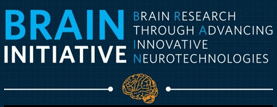
President Obama announces BRAIN Initiative
UC San Diego, 'Mesa' colleagues and private-public partners to play key roles
TDLC co-Director Terry Sejnowski "joined President Barack Obama in Washington, D.C., on April 2, 2013, at the launch of the Brain Research through Advancing Innovative Neurotechnologies (BRAIN) Initiative—a major Administration neuroscience effort that advances and builds upon collaborative scientific work by leading brain researchers such as Salk's own Sejnowski." (taken from Salk News Release). For more information:
|
Gamelan and SIMPHONY Projects in BBC News Online
Power of Art: Can music help treat children with attention disorders?
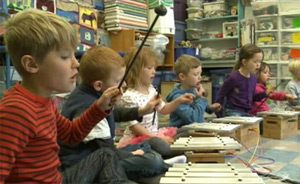 What is the effect of music on the brain? What is the effect of music on the brain?
A growing body of research delves into this question, made possible by new imaging technology that allows scientists to determine how different areas of brain function are connected. An example of this new focus on music and the brain is the Gamelan Project, led by TDLC investigator Alexander Khalil. The study, funded by the National Science Foundation, suggests that learning to play a musical instrument can improve our ability to focus attention. Working with children at the Museum School in San Diego, Alex Khalil monitors the children's ability to hit the beat precisely using a musical instrument called the Gamelan. He then analyzes the data using a mathematical algorithm to determine their accuracy. "So far, we've found a correlation between their ability to synchronise and their performance on cognitive tests."
In another study on music and the brain, John Iversen of the Institute of Neural Computation (INC) at UC San Diego is heading the SIMPHONY Project, one of the first longitudinal studies of its kind on the effects of musical training on brain development. SIMPHONY is being done in collaboration with TDLC researcher Dr. Terry Jernigan of the Center for Human Development. John Iversen explains, "To really understand whether it's music making these brain changes, you have to study someone as they begin to learn music and as they continue learning music. Then you can see how their brain develops and compare that with children not doing music." TDLC investigator Paula Tallal adds, "We know from multiple studies that children who have musical training do better at school ... We're interested in why that occurs. What neural mechanisms are being driven by musical experience and how do they interact with other abilities." It could take years before study results are known, but the results could have far-reaching implications. Read the article 
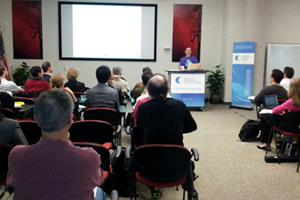 TDLC All Hands Meeting 2013 TDLC All Hands Meeting 2013
BROADEST, BIGGEST EVER …
It may well be that any event improves with practice,
but it remains that TDLC's February 7-9, 2013 All Hands Meeting not only broke its own records for planning, organization and smooth running, but also for an enhanced Trainee program plus quantity of intriguing research presentations and questions.
As always, Roger Bingham and crew videotaped the proceedings for online viewing on The Science Network (TSN) http://thesciencenetwork.org/ (coming soon). And this time around the annual get-together included content
for not only scientists but teachers: Twenty-five or more of the San Diego contingent of Doris Alvarez's Educators Network plus a few of the 21 members of the newly-formed Colorado Branch of TEN, with host PI TDLC's Mike Mozer.
As Paula Tallal (TDLC Executive Committee member and Rutgers University Neuroscience Professor) commented, "It is really interesting to see how far we have come over the years of TDLC funding, in better understanding of nesting time scales and how this is contributing to better inform our understanding of the role of time and timing in learning. Being able to focus so centrally on scientific integration was excellent and really set the stage as we consider the most important research to do in the last three years of TDLC's NSF funding." More
|
|

|
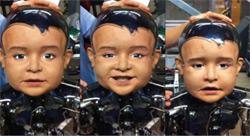 Robot baby Diego-san, built by the Machine Perception Lab at Robot baby Diego-san, built by the Machine Perception Lab at
UC San Diego
(with TDLC's Javier Movellan)
is featured
in recent press
Diego-san, a robot based on a one year old baby, has been designed to study the cognitive development of infants. The lab received funding from the National Science Foundation to contract Kokoro Co. Ltd. and Hanson Robotics, two companies that specialize in building lifelike animatronics and androids. Recent press includes:
Autism's Own Conference:
Celebrating World Autism Awareness Day, April 2, 2013
The Autism's Own Conference was founded by the local autism community, along with support by University of Victoria's Centre for Autism Research, Technology, and Education (CARTE). The Centre is supported by TDLC funds and directed by TDLC's Jim Tanaka.
Along with dynamic talks, poetry, dance, live piano, and a theatrical performance -- all by persons with autism -- the dynamic event featured
demonstrations of CARTE's newest autism intervention technologies (including a demo of TDLC's Marni Bartlett and the CERT programs). It also featured an online display of Autism's Own Journal, a UVic peer-reviewed journal featuring topics about autism by writers with autism. For more information:
TDLC Celebrates Brain Awareness Week with Webinar on 3/12/13
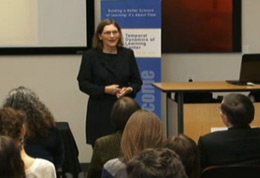
The Educator Network of TDLC presented, "How to Learn More Deeply and Creatively: Concrete Tools from Neuroscience and from Zombies," with featured speaker
Barbara Oakley, renowned Author and Associate Professor in the School of Engineering
and Computer Science at the University of Oakland.
This captivating presentation was sponsored by TDLC and TDLC's Educator Network (coordinated by Doris Alvarez) in celebration of Brain Awareness Week (BAW) -- the global campaign to increase public awareness of the progress and benefits of brain research. Over 215 people registered for the Webinar, with 150 attending in person. The audience consisted of TDLC researchers and over 75 high school students and their teachers. The Webinar streamed to over 100 participants from states such as Colorado and New York, and to countries as far away as Poland, Canada, Australia, and Portugual.
Barbara Oakley captivated the packed auditorium with her discussion of the brain and different ways of thinking about thinking. She discussed the two modes of thinking: Focused mode and diffuse mode. Based on the latest scientific research about how the brain learns, she shared strategies on how to solve problems, improve test-taking, combat procrastination, and better learn and retain information. The presentation was followed by a Distinguished TDLC Scientists Panel with Andrea Chiba, Terry Sejnowski, and Paula Tallal.
Click here for a summary of the presentation
Watch the Webinar Recording
 5th Annual San Diego Brain Bee Neuroscience Competition 5th Annual San Diego Brain Bee Neuroscience Competition
TDLC was one of the sponsors of the 5th Annual San Diego Brain Bee Neuroscience Competition that was held on February 10, 2013, in the Cal-IT2 Auditorium at UC San Diego. The event, a live question and answer competition, is designed to teach high school students from around the world about the brain. More
|
|
|
 |
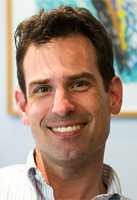 Featured Scientist:
John Iversen Featured Scientist:
John Iversen
Institute of Neural Computation, UC San Diego
Email: jiversen@ucsd.edu
Website: http://www.nsi.edu/~iversen/
John Iversen is interested in the use of music perception and production as a tool for the study of complex brain processes, including those that may underlie language. We asked him "How can music be used as a tool to understand the brain?"
Music has a powerful, nearly universal influence on human culture as well as on the individual. Listening to or making music is a cognitively demanding and rich activity that involves many fundamental brain processes, making the study of music an attractive way to understand not only music, where it came from and what it does for us, but more general aspects of brain function such as the perceptual organization of complex temporal inputs, sensorimotor integration, skill learning, memory, emotion, and social interaction to name a few. Music is also attractively decomposable as a stimulus--one can study e.g. melody, or timing separately, but at the same time is also richly hierarchical in structure, as is language, making it a potent tool for the study of the brain.
One of my main interests is in the perception and production of rhythm, a topic that addresses how we structure events in time, and also has implications for medicine and education. Rhythm is central to how we perceive structure and meaning in music and language, and shapes how we move our bodies. This strong link between rhythm in perception and action underlies spoken language and dance, but is also of growing interest for the treatment of movement disorders due to Parkinson's or stroke. Because musical rhythm in (most!) healthy people can powerfully organize our movements, it holds promise for reorganizing the movements of people who may have lost the ability to do so themselves. We are studying the brain mechanisms of rhythm perception and production to understand this link, how it might be compromised by disease, and how music could intervene. This is one example of ways in which the field is trying to use music not only for emotional and social support, but also more target neural interventions.
Our goal is to understand not only how music moves us, but how it might change our brains. Several TDLC projects are studying how music might play a role in eduction by influencing the developing brain. We know that the brains of musicians differ in interesting ways from non-musicians, but only now are we conducting the necessary interventional and longitudinal studies to test if these changes are due to music training, and not just innate individual differences. As part of the PLING (Pediatric Longitudinal Imaging, Neurocognition, and Genetics) project run by TDLC member Dr. Terry Jernigan of UCSD's Center for Human Development, the SIMPHONY project is one attempt to define the impact of music on cognitive and brain development, with the aim of testing if music accelerates aspects of normal development. We are studying a cohort of children learning to play a musical interest and comparing them to children learning a martial art and to other children learning neither using a large battery of behavioral and brain structural and functional measures. One link we will test, which has been increasingly supported by evidence, is the impact of music training on language learning. Music and language share many neural mechanisms, and it may be that the intense demands on the auditory system required by music can have benefits to the perception of language sounds as well. Our interest in music as a tool to shape brain development falls within a larger trend to look again at the proper role of the arts in education.
|
|
This message was sent from:
The Temporal Dynamics of Learning Center (TDLC.UCSD.EDU)
University of California, San Diego,
9500 Gilman Drive, La Jolla, CA 92093
To learn more about TDLC, please visit us on the web at: TDLC.UCSD.EDU
Please contact webmaster@tdlc.ucsd.edu to unsubscribe.
TDLC is a Science of Learning Center (SLC),
one of six SLCs funded by the National Science Foundation. NSF grants SBE 0542013 and SMA 1041755.
|
|
 |
 |
 April 2013 April 2013
|
|

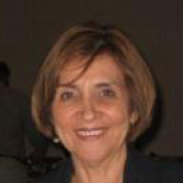
TDLC's The Educator Network
Recent
Forum Topic:
Exercise and Academic Performance
A new study soon to appear in The Journal of Pediatrics shows evidence of the importance of aerobic exercise for increasing test scores. Unfortunately many school districts reduce the time for physical education in order to increase test scores by focusing on more reading, writing and math. What is your experience in your districts?.
Click here to read the article.
|
|
|
 |
 |
Superhero Supercomputer Helps Battle Autism (ScienceDaily,
Mar. 26, 2013)
In January 2012, San Diego Supercomputer Center (SDSC) went online with supercomputer Gordon (commissioned by the NSF in 2009).
Last month, a team of researchers from SDSC, the U.S. and the Institute Pasteur in France reported in the journal Genes, Brain and Behavior that "they used Gordon to devise a novel way to describe a time-dependent gene-expression process in the brain that can be used to guide the development of treatments for mental disorders such as autism-spectrum disorders and schizophrenia."
Read article 
|
 |
Mysterious muscle disorder rooted in brain (NBC Vitals)
Read article 
|
 |
The Economic Benefits of Mapping the Human Brain
(Marketplace, 2/13)
Read article 
|
 |
Obama Seeking to Boost Study of Human Brain
(The New York Times, Feb 2013)
Read article 
|
 |
How Neuroscientists are Hacking into Brain Waves to Open New Frontiers
(NBC News, Feb 2013)
Read article 
|
 |
A timely new journal:
Trends in Neuroscience and Education
Trends in Neuroscience and Education is an exciting journal that aims to bridge the gap between "our increasing basic cognitive and neuroscience understanding of learning and the application of this knowledge in educational settings. It provides a forum for original translational research on using systems neuroscience findings to improve educational outcome, as well as for reviews on basic and applied research as relevant to education, project reports, best practice examples, and opinions regarding evidence based educational policies and related subjects." (taken from Elsevier)
Read more 
|
 |
Smart jocks: Fit kids do better on math, reading tests
(MSN Health)
Read article 
|
 |
How Do I Improve My Memory? Forget More!
(Huffington Post 2/13)
Read More
|
 |
This is your brain on smoking
In a study published in the journal Age & Ageing, a consistent association was observed between smoking and lower cognitive functioning, including memory.
Read More
|
 |
Revealing new photos of Einstein's brain
(CNN Anderson Cooper 360)
Read More
|
 |
Woman uses thought control to eat chocolate
A woman who was diagnosed with spinocerebellar degeneration was able to feed herself through the help of a mind-controlled robot arm created by researchers at the University of Pittsburgh and UPMC.
Read More
|
 |
Scientists identify unselfish brain cells in monkeys
Animal kindness may provide clues to neural basis of altruistic acts
Read More
|
 |
Blinking gives your brain a break
"Nakano and her colleagues found that when we blink while paying attention to a task, we're resetting our brain. Think of it like rebooting your computer."
Read article 
|

|
What causes people to itch?
Scientists have recently discovered "itch nerves" that sit inside the spine, near the spinal cord. Neuroscientists at Johns Hopkins University (Xinzhong Dong and colleagues) have found that certain nerve cells are specialized to detect itchy sensations, and those receptors don't detect painful sensations.
This finding, published in the journal Nature Neuroscience in Dec. 2013, could potentially help scientists develop better anti-itch treatments. While these newly discovered nerves don't explain all itchiness (other nerves probably exist that can sense both itch and pain), treatments that target these "itch nerves" could be a huge improvement over current treatments such as steroids and antihistamines. More ...
(reference:
LiveScience)
|
|
|
 |

![]()
